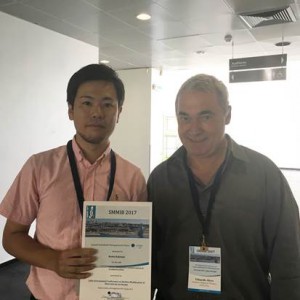2017年07月19日
【受賞/表彰等】原子力国際専攻M2垣谷健太さんがSMMIB-2017 Young Researcher Awardを受賞されました。
【受賞/表彰等】原子力国際専攻M2垣谷健太さんがSMMIB-2017 Young Researcher Awardを受賞されました。
<受賞された研究・活動について>
1. 氏名 垣谷 健太
2. 学部・研究科、学科(類・課程)・専攻等 と学年
工学系研究科 原子力国際専攻 修士2年
3. 受賞した賞の名称と簡単な説明
SMMIB-2017 Young Researcher Award
International Conference on Surface Modification of Materials by Ion Beams (SMMIB-2017)はイオンビームによる材料表面改質に関する国際学会であり、隔年で開催されている。第20回に当たるSMMIB-2017はポルトガルのリスボンで5日間に渡って開催され、約200件のプレゼンテーションがなされた。その中でも特に優れた学生発表に対してYoung Researcher Awardが授与された。
4. 受賞された研究・活動について
タイトル:The Interface between Platinum Nanoparticle Catalysts and an Ar+-Irradiated Carbon Support
これまでに、予めArイオンを照射した炭素担体上の白金ナノ粒子触媒が高い酸素還元反応(ORR)活性を示すことを見出している。この結果は担体に形成した照射欠陥が白金触媒に影響を及ぼしていることを示唆するが、その詳細は明らかになっていない。そこで本研究では、照射欠陥が白金ナノ粒子の形状、化学状態に及ぼす影響をそれぞれ透過型電子顕微鏡観察、X線吸収端近傍構造(XANES)測定により調べることで、高活性化をもたらす界面効果の解明を目指した。380 keV Arイオン照射のグラッシーカーボン基板にスパッタ蒸着により白金ナノ粒子を作製したところ、その平均粒径は5.1 nmで非照射の場合よりも1.3 nm大きかった。一方、Pt M3端およびL3端におけるXANESスペクトルでは、ピーク強度が非照射の場合に比べて低く、白金触媒の酸化抑制傾向が見出された。従って、照射による高活性化は、ナノ粒子の粒径変化では説明できないが、酸化抑制効果によるORR律速段階(酸素種の白金表面からの脱離)の促進と関連していることがわかった。
5. 今後の抱負・感想
Young Researcher Awardを受賞することができ、光栄に存じます。今後もイオンビームによる材料表面改質を利用した研究に全力で取り組む所存であります。
1. Name
Kenta KAKITANI
2. Faculty/Graduate School, Department (Stream / Program) / Major and Year in university
School of Engineering/ Department of Nuclear Engineering and Management/ Master’s 2nd year
3. Name of award and short explanation about the award
SMMIB-2017 Young Researcher Award
International Conference on Surface Modification of Materials by Ion Beams (SMMIB-2017) gathers scientists from all over the world to exchange ideas, share new knowledge and future trends of ion beam technologies. The conference was held in Lisbon, Portugal, on July 09-14, 2017. About 200 presentations were given at the conference, and Young Researcher Award was given to the student who gave a superior presentation.
4. About awarded research(activity)
Presentation Title:
“The Interface between Platinum Nanoparticle Catalysts and an Ar+-Irradiated Carbon Support”
Pt nanoparticles (NPs) on the Ar+-irradiated carbon support were found highly active for the oxygen reduction reaction (ORR). This suggests that irradiation defects of the support would affect Pt NPs, but the mechanism of the activity improvement has not been clear. We performed here transmission electron microscopy and X-ray absorption near edge structure (XANES) measurements to investigate the effect of the Pt NP-support interface in terms of the size and chemical states of the Pt NPs. The Pt NPs were prepared on the glassy carbon substrate by sputter deposition; their sizes were 5.1 and 3.8 nm on the 380 keV Ar+-irradiated and pristine substrates, respectively. In XANES spectra at Pt M3 and L3 edges, the peak intensity was lower for the irradiated sample, indicating the suppression of Pt oxidation by the irradiation defects. Accordingly, fast kinetics originating from this interfacial chemical-state change, not an increase in the particle size, can explain the high ORR activity.
5. Your impression & future plan
I’m honored to be given the Young Researcher Award. I’m determined to make more progress in the research on the material modification by the ion-beam irradiation.



